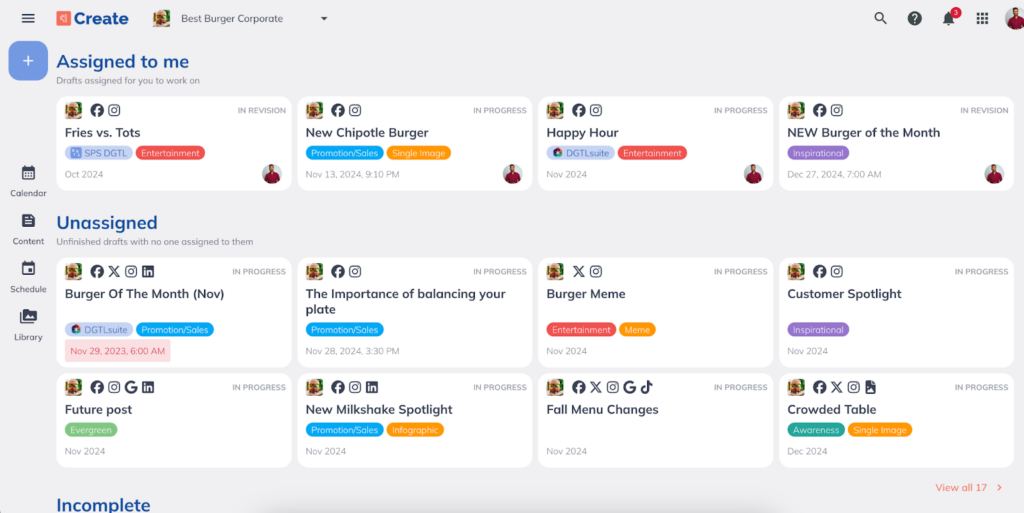Social media content is a key part of brand visibility and customer engagement. However, without a solid approval workflow, maintaining consistency in messaging, quality, and brand compliance can be a huge chore.
Luckily, a social media approval workflow can set up clear steps for reviewing and approving content. This helps make sure everything shared aligns with brand standards and is free from errors.
Every team is different, so it’s important to create a workflow that fits your unique needs. But how to build a custom approval process for your own team?
In this article, we’re explaining the process in seven detailed steps. First, let’s define the basics.
What is a Social Media Approval Workflow?
A social media approval workflow is a structured process that defines each step for reviewing and approving content before it’s posted. This makes sure that every piece of content meets brand standards and goals.
Key aspects of a social media approval workflow include:
- Clear roles and responsibilities: Assigns tasks to specific team members, from content creators to approvers.
- Guided content flow: Outlines the process from initial creation to final approval.
- Comprehensive content checks: Makes sure images, captions, and videos are reviewed for quality and relevance.
- Error prevention: Helps avoid costly mistakes, such as typos, off-brand messaging, or compliance errors.
- Easier communication: Reduces unnecessary back-and-forth by clarifying when and how team members should review content.
In short, a well-structured workflow is key to producing high-quality content that builds trust and engages the audience.
What Are The Benefits of Having a Social Media Approval Process?
If you don’t have an established social media approval workflow, you could be missing out on these advantages:
Better Content Quality
No one wants to see typos or poorly crafted captions in their social media feeds. With an approval workflow, every post is reviewed to ensure grammar, tone, and messaging are polished.
This process helps guarantee your audience always sees professional, high-quality content that reflects your brand’s standards.
Maintained Brand Consistency
Your brand’s voice and style should remain consistent across every platform.
An approval workflow keeps everyone on the same page, so your messaging feels unified and recognizable, no matter who is creating the content. It’s how you build trust and loyalty with your audience.
Fewer Costly Mistakes
One wrong post can damage your brand’s reputation. An approval workflow minimizes risks by catching errors, from compliance issues to off-brand messaging.
This proactive approach protects your brand and saves you from potential backlash.
Easier Team Collaboration
Confusion over who’s responsible for what? Not with a social media approval workflow.
Roles and responsibilities are clearly defined, keeping everyone aligned and avoiding unnecessary back-and-forth. It’s a stress-free way to keep your team productive and efficient.
On-Time Publishing
Deadlines are extremely important in social media, especially for time-sensitive campaigns. A structured workflow keeps everything on track so that posts are reviewed, approved, and published according to your schedule.
Improved Accountability
With an approval workflow, you can track every step of the process—who created the content, who reviewed it, and who gave the final go-ahead.
This transparency helps make sure everyone knows their role and keeps the process running smoothly.
Easy Scalability
As your team grows or your social media efforts expand, a clear workflow becomes even more valuable. It helps you handle higher volumes of content without losing efficiency, which makes it a scalable solution for growing businesses.
Types of Social Media Approval Workflows
These are the different types of social media approval workflows, each designed to suit varying team sizes, content complexities, and organizational needs.
Here’s a breakdown of each one to help you choose the right marketing approval process for your business:
Single-Step Approval
Single-step approval is a straightforward process, often used by small teams or for routine, low-risk content. In this setup, one person reviews and approves the content, allowing for quick turnaround times.
This method is ideal when there are fewer people involved in content creation.
Multi-Step Approval
Multi-step approval is common in larger teams or organizations with layered responsibilities.
In this workflow, content passes through several stages—starting from the content creator, moving to an editor, then perhaps to a compliance officer, and finally to a social media manager for final approval.
Tiered Approval
Tiered approval is often used when handling high-stakes or regulated content, such as in finance, healthcare, or government sectors. Content is routed to different departments for specific approvals based on their expertise.
For example, marketing reviews the message, legal checks for compliance, and PR assesses potential impact.
Collaborative Approval
In collaborative approval workflows, multiple marketing team members provide feedback and approve content before it goes live.
This setup is ideal for content requiring input from different areas, such as marketing, legal, and public relations.
Collaboration helps align your content with brand standards while also avoiding potential legal or public relations issues.
Automated Approval
Automated approval workflows use tools to streamline the process by sending automatic reminders and setting deadlines for reviews. Automation helps content move smoothly through each stage without delays or missed approvals.
This setup is especially useful for teams handling high volumes of content, as it reduces the need for manual tracking and keeps the workflow efficient and timely.
7 Steps to Create a Social Media Approval Workflow
Here is a step-by-step guide to creating your own social media approval processes:
Step 1: Define Team Roles and Responsibilities
To build an efficient social media approval workflow, the first step is to define who will be involved and what each person is responsible for.
Clear roles prevent confusion, organize the approval process, and make sure everyone knows their specific tasks. Start by listing everyone who will be part of the workflow. This typically includes roles like:
- Content creator: The person responsible for creating social media posts, including writing copy, designing visuals, or producing videos
- Editor: Reviews the content for grammar, accuracy, and brand tone, making edits as needed
- Compliance officer (if applicable): Checks for compliance with legal or industry standards, especially for regulated industries like finance or healthcare
- Manager: Often responsible for the final review and making surethe content aligns with broader brand goals
Assign Responsibilities
Once you’ve identified each team member, define their role in the workflow. This helps avoid overlap and guarantees each stage of approval is clear. For example:
- The content creator submits drafts
- The editor makes necessary revisions
- The compliance officer confirms regulatory compliance
- The manager approves or requests final changes
Don’t forget to set clear accountability by explaining who gives the final approval and publishes the content.
In some cases, social media managers may be the final approver, while in others, they may be dedicated social media leads.
 Step 2: Outline the Approval Stages
Step 2: Outline the Approval Stages
A structured workflow requires outlining the key stages content will pass through, from initial draft to final approval.
Once you map these strategies, you can make sure each piece of content is thoroughly reviewed and any potential issues are caught early.
Start by deciding how many stages are necessary for your content. A small team may only need a single-step approval, where one person reviews and approves content before it’s published.
Larger teams or high-stakes content might benefit from a multi-step approval process, involving several reviewers, such as editors, compliance officers, and managers.
In cases where input from various departments is essential, consider a collaborative approval that includes multiple team members from different areas.
Map Out Each Stage
Once you’ve established the number of stages, create a document that outlines each step in the process. For example:
- Content creation: The initial draft is created by the content creator.
- Editing: The editor reviews and revises the draft for grammar, tone, and accuracy.
- Compliance check: If needed, the compliance officer checks for regulatory adherence.
- Final approval: The manager or designated approver gives the green light for publication.
Step 3: Set Up Deadlines and Timelines for Each Stage
Deadlines keep the approval process on track. They help content move smoothly from creation to publication.
If you set up clear timelines based on your social media posting schedule, you’ll reduce bottlenecks and make sure your social media posts are both timely and relevant.
To prevent delays, specify how long each stage of the review process should take. For instance:
- Content creation: 1-2 days
- Editing and revisions: 1 day
- Compliance check (if needed): 1-2 days
- Final approval: 1 day
This way, content can be approved and ready to publish without last-minute scrambling.
Add Reminders and Escalation Procedures
You can use tools with automated reminders to keep the process moving. Social media platforms with built-in workflow features can send reminders for pending approvals so team members don’t forget their tasks.
Additionally, establish an escalation procedure—a backup plan if someone misses a deadline. For example, designate a secondary reviewer who can step in to approve content when the primary approver is unavailable.
Define Publishing Schedules
Finally, align your approval timelines with your content publishing schedule, especially for posts tied to specific events or deadlines.
Time-sensitive posts, like new social media campaigns or announcements, should have priority in the workflow.
 Step 4: Develop Approval Criteria and Guidelines
Step 4: Develop Approval Criteria and Guidelines
Clear criteria and guidelines help make every piece of content passing through your workflow meet your brand’s standards.
With a structured checklist, team members know exactly what to look for, which keeps content consistent and minimizes errors.
Start by developing a checklist that team members can use at each stage of the approval process. The checklist should cover:
- Brand tone and messaging: Verify that the content reflects the brand’s voice and intended message
- Consistency: Make sure that all elements—text, images, and captions—align with each other and your brand’s standards
- Compliance requirements: If applicable, include any legal or regulatory checks specific to your industry
- Other specific guidelines: Add any other instructions relevant to the post, such as required hashtags or preferred keywords
Step 5: Choose Tools to Support the Workflow
Using tools like Trello or Asana can help manage team tasks and keep track of each stage in the workflow.
For a more social media-focused approach, tools that integrate task tracking and content management are even better.
DGTLsuite offers a comprehensive solution for social media approval workflows. Its DGTL Create tool supports social content planning, scheduling, and collaboration.
 Team members can work together efficiently, leave in-context comments on posts, and track content revisions and approvals in real time.
Team members can work together efficiently, leave in-context comments on posts, and track content revisions and approvals in real time.
Automated task notifications and deadline management features help your content move smoothly through each stage, which reduces delays.
DGTLsuite also offers flexible permissions. Teams can assign visibility and access based on roles. This setup means that each member has the right access level for their tasks, which smoothens out collaboration and secures sensitive information.
With a centralized media library, teams can easily organize assets and attachments from a central location to create and deliver visually engaging social content.
Step 6: Build Templates for Consistency
Templates make it easier to create and approve content efficiently while also delivering consistency across posts.
You can set up templates for common types of content like captions, visuals, and post formats. When you standardize these elements, each piece will reflect your brand’s tone, style, and structure, which also speeds up the content creation process.
Create’s built-in draft submission forms keep your content process consistent throughout each workflow stage, covering areas like compliance checks, brand tone, and required elements (e.g., hashtags). As a result, you’ll minimize errors and provide clear guidance to each reviewer.
Step 7: Test, Test, Test
Choose a small batch of content to run through the new workflow as a trial. This way, you will be able to assess how well each step functions in practice.
After the test, don’t forget to ask team members for input on each workflow stage. Their feedback will highlight any areas where the process might need improvement.
Based on test results and feedback, make adjustments to improve clarity, efficiency, and ease of use.
Take Control of Your Social Media Workflow with DGTLsuite
 Managing social media workflows is easier with DGTLsuite, a platform designed to streamline content creation, collaboration, and approvals.
Managing social media workflows is easier with DGTLsuite, a platform designed to streamline content creation, collaboration, and approvals.
DGTLsuite allows teams to stay organized and on schedule. Users can comment on drafts, track revisions, and manage approvals from a single dashboard.
By setting permissions and roles, you can make sure each team member is involved exactly where they’re needed, from content creation to final approval!
Optimize your social media marketing with DGTLsuite and keep every piece aligned with your brand’s standards. Book a discovery call today!
FAQs About Social Media Approval Workflow
What is the social media post approval workflow?
A social media post approval workflow is a structured process for reviewing and approving content before it’s published. This workflow is essential for social media managers, especially in settings with multiple stakeholders, to make sure that content aligns with brand standards. Social media approval tools are key for teams, as they allow a social media agency to manage multiple social media accounts to streamline reviews and stay on the same page.
What is the workflow for approvals?
An approval workflow involves multiple stages, where content is reviewed by designated team members before it’s posted. Social media management tools simplify this process by enabling teams to organize feedback, approve content across platforms, and maintain a consistent brand voice across multiple accounts.
What is social media approval?
Social media approval is the process of reviewing and confirming content before it’s shared. Using a social media approval tool, agencies and brands can ensure that only approved posts go live.
What is a social media workflow?
A social media workflow is the end-to-end process that guides content from creation to publication. It often involves planning, creation, editing, and approval, helping social media managers and agencies manage multiple social media accounts and keep every team member on the same page.
How does a social media approval process fit into a social media strategy?
A social media approval process is a big part of a well-rounded social media strategy. Teams can keep posts consistent with brand goals and messaging by maintaining that content passes through structured reviews. This process also supports timely, coordinated content across multiple accounts, helping the team stay organized and on-brand.






